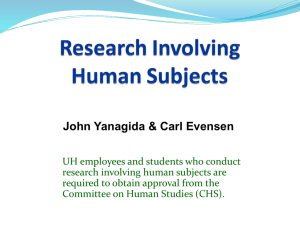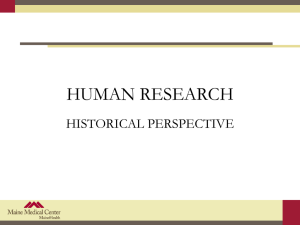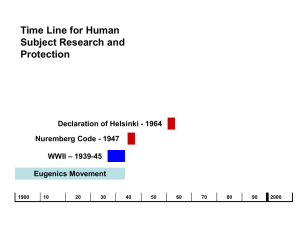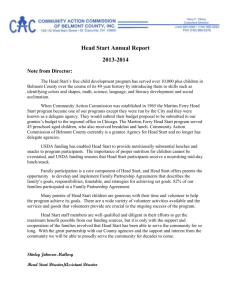Human Subjects-Anthropology 1020
advertisement
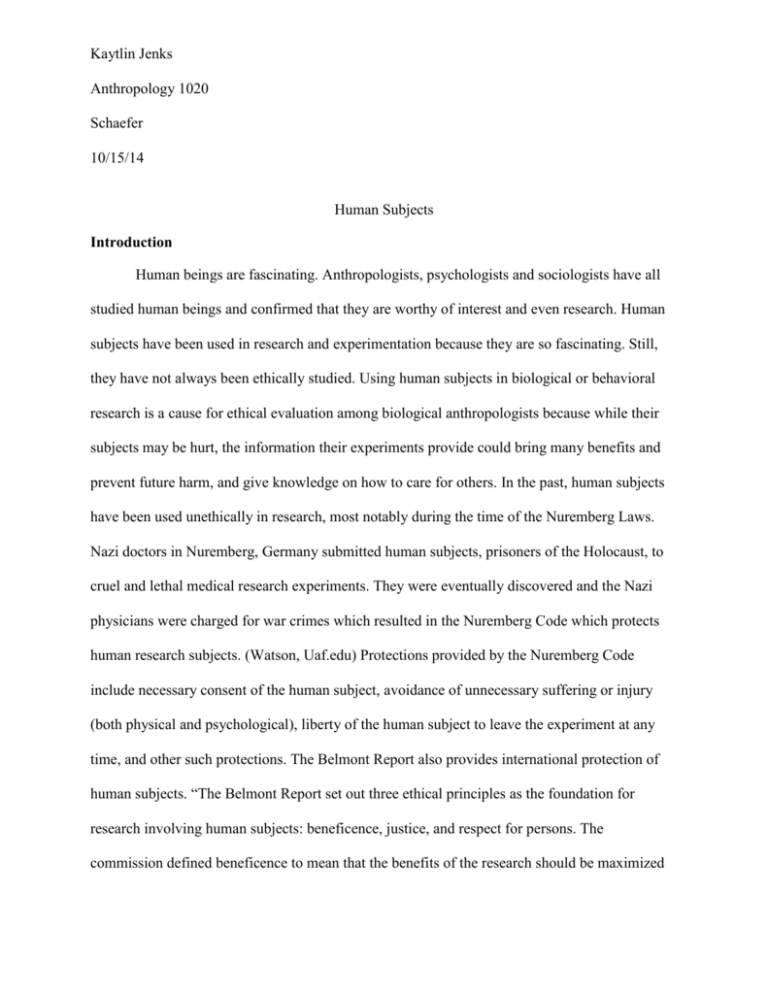
Kaytlin Jenks Anthropology 1020 Schaefer 10/15/14 Human Subjects Introduction Human beings are fascinating. Anthropologists, psychologists and sociologists have all studied human beings and confirmed that they are worthy of interest and even research. Human subjects have been used in research and experimentation because they are so fascinating. Still, they have not always been ethically studied. Using human subjects in biological or behavioral research is a cause for ethical evaluation among biological anthropologists because while their subjects may be hurt, the information their experiments provide could bring many benefits and prevent future harm, and give knowledge on how to care for others. In the past, human subjects have been used unethically in research, most notably during the time of the Nuremberg Laws. Nazi doctors in Nuremberg, Germany submitted human subjects, prisoners of the Holocaust, to cruel and lethal medical research experiments. They were eventually discovered and the Nazi physicians were charged for war crimes which resulted in the Nuremberg Code which protects human research subjects. (Watson, Uaf.edu) Protections provided by the Nuremberg Code include necessary consent of the human subject, avoidance of unnecessary suffering or injury (both physical and psychological), liberty of the human subject to leave the experiment at any time, and other such protections. The Belmont Report also provides international protection of human subjects. “The Belmont Report set out three ethical principles as the foundation for research involving human subjects: beneficence, justice, and respect for persons. The commission defined beneficence to mean that the benefits of the research should be maximized Jenks 2 and the harms minimized. The principle of justice requires that the benefits and burdens of research be fairly distributed. Respect for persons entails the ideas that individuals should participate in research voluntarily and with adequate information, and that there should be special protections for those with diminished autonomy.” (Stinson, 140-141) There are two viewpoints to consider when performing research with human subjects; one is that human subjects could be hurt, embarrassed, stigmatized, disabled and in extreme cases die, though these outcomes are less likely with the Nuremberg Code and Belmont Report in place, and therefore shouldn’t be an issue but should still be considered. The other viewpoint is that using human subjects in research provides information that will aid in human survival now and in the future and is therefore necessary for advancement of the species. It could provide knowledge that will increase life span, well-being, standards of living as well as more suitable psychological and medical assistance, enhance nutrition and improve laws. My initial opinion was that human subjects should never be used in research. This opinion has broadened; human subjects should only be used in research with their consent, forewarning of potential outcomes and under the Nuremberg Code and Belmont Report. Viewpoint 1 No one on Earth likes the idea of pain, especially when intentionally inflicted on another human being who does not deserve it. Human research subjects are exposed to conditions that may cause pain, or other suffering. The International Review Board or IRB and other human rights activists care deeply about these human subjects and what research involving them may cost them. Examples of previous experiments where human subjects’ rights were violated include (but are not limited to); the Nuremburg experiments, Tuskegee Syphilis Experiment, diethylstilbestrol experimentation, Project 4.1, the Stanford Prison Experiment and the Milgram Jenks 3 Study. Both the Nuremberg and Tuskegee experiments were intended to advance medicine and left their subjects to suffer and die without any relief and in the case of Tuskegee, the subjects didn’t even know what was happening. Project 4.1 subjects suffered because “No one was warned about the radiation dangers or hazards. [Human Subjects] were called 'savages'. Women on the island after the bomb gave birth to deformed, mentally retarded children. 91% of these [Human Subjects] had blood disorders caused by radiation.” (Dr. Good Heart, agreenroad.blogspot.com) Subjects of diethylstilbestrol experimentation were injected, unknowingly, with diethylstilbestrol, synthetic estrogen while pregnant. Both groups’ children experienced birth defects. The Stanford Prison Experiment and Milgram Study were designed to learn about the human mind and how acts of evil come about. While people were hurt both during and after the Stanford experiment, both experiments left their human subjects with the knowledge of how much evil they are truly capable of, and a mountain of guilt to work through for the rest of their lives. These are powerful examples of why humans should not be used in research without strict adherence to the Nuremberg Code and Belmont Report. These experiments caused their subjects unnecessary harm no human should have to endure. They people would have been much safer under these guidelines proving that researcher should not try in any way to go around or ignore them. There is a fallacy to completely banning using human subjects in research studies; avoiding use of human subjects to keep them from harm may increase the likelihood of others suffering in the future because of is insufficient research on how to prevent something such as an illness or disorder. There are some things that just cannot be learned without certain types of research (i.e. medicine in medical research), but if this research puts human subjects at risk of social stigma, pain, guilt, embarrassment, death or any other type of suffering, then it is not worth it. Jenks 4 Viewpoint 2 The best way to learn about human beings is to study them. Learning about humans enables psychologists, sociologists, those in the medical field and anthropologists to identify problems causing the human species to suffer and provide solutions. When done under the Nuremberg Code and Belmont Review, experiments involving human research subjects can provide information necessary for improvement. Areas of improvement include (and are again not limited to); nutrition, exercise, health interventions, social work, psychological counseling and workplace safety. These things all increase quality of life. There are so many cases of ethical experiments that have been done and successfully, with minimal or no harm to human subjects, that finding one to stand out is difficult. Human subjects exposed to experimentation under the Nuremberg Code and Belmont Report have given researchers the information they need to develop and test new drugs that expand lifetime, create fitness plans based on nutrition and exercise of various groups, and that have given necessary information about when and how health interventions need to be addressed. Human bodies are healthier and stand a much greater chance at surviving with the information provided by willing human subjects. These are great reasons why human research should be done and how information on these human subjects truly provides for the welfare of all people. Still, there is some chance, however unlikely, that human subjects may be hurt or suffer in some way. A fallacy regarding the use of human subjects without restraint is that there is no guarantee the research done on the human subjects would be benefial to the species. It might prevent advancement. Because human subjects are a part of active experimentation, they really can’t know all the specifics about what is going to happen because it hasn’t happened yet. Even in the most humane and ethical circumstances, due to the nature of experimentation, human subjects can never be completely sure they will not suffer. Jenks 5 Despite that negative hypothetical situation, under normal circumstances if all Nuremberg Code and Belmont Report principles are being met, the human subjects should be fine. Conclusion From an unbiased perspective, one could say that it is not ethical for human research subjects to be used in biological research and that without them the species is not likely to advance. While both are great arguments, though conflicting, the one that makes a more persuasive claim is against human subjects being allowed in biological research. Even if sheer numbers speaks for the claim for use of human subjects in research as well as theoretical glorious outcomes, historical accounts of actual negative outcomes of human research subjects scream from the past to have human subject research brought to an end. Human subjects could be anyone (who volunteers), including one’s friends and family. Experiments that bring knowledge of health and cures bring happiness, while the prospect of human subjects suffering brings only misery. At the same time there are multitudes of various people involved in the benefits of execution of the experiments (the human subjects themselves), there are plenty of people behind the research including (and once again not limited to); biological anthropologists, psychologists, sociologists and those in the medical field, all of whom hope to gain valuable information from experimentation that will allow them to take better, more precise care of others in the future. While my initial opinion did not change dramatically, it did broaden. Humans should not be used in biological research unless the Nuremberg Code and Belmont Report are strictly followed, the humans are fully aware of what is happening to them and effects of the experimentation are not detrimental or life-long. These experiments should be used to benefit society and never to hurt any one of its members, specifically the human research subjects. Jenks 6 Works Cited Brunner, Borgna. "The Tuskegee Syphilis Experiment." Infoplease. Infoplease, 2007. Web. 13 Oct. 2014. <http://www.infoplease.com/spot/bhmtuskegee1.html>. "Diethylstilbestrol." Wikipedia. Wikimedia Foundation, 13 Oct. 2014. Web. 14 Oct. 2014. <http://en.wikipedia.org/wiki/Diethylstilbestrol>. Dr. Good Heart. "Teaching A Science Of Sustainable Health/Success: Project 4.1 - Human Radiation Experiments With Bikini Atoll Residents Exposed To Nuclear Bomb Fallout." AGreenRoad Project…Project 4.1. Dr. Good Heart, 6 May 2013. Web. 13 Oct. 2014. Kalichman, Michael, and Francis Macrina. "RCR Internet Instruction: Assignments." RCR Internet Instruction: Assignments. RCR Education Committee, Jan. 2008. Web. 12 Oct. 2014. Stinson, Sara. "Ethical Issues in Human Biology Behavioral Research and Research with Children." Biological Anthropology and Ethics: From Repatriation to Genetic Identity. Comp. Trudy R. Turner. Albany: State U of New York, 2005. 139-47. Print. United States of America. United States Department of Health and Human Services. N.p., n.d. Web. 12 Oct. 2014. <http://www.hhs.gov/ohrp/archive/nurcode.html>. Washington, Harriet A. "Human Research Protections Are Being Routinely Ignored." Slate Magazine. New Scientist, 22 Jan. 2012. Web. 14 Oct. 2014. Watson, Bridget. "Human Subjects in Research." Office of Research Integrity. Office of Research Integrity, 10 Jan. 2013. Web. 10 Oct. 2014.

